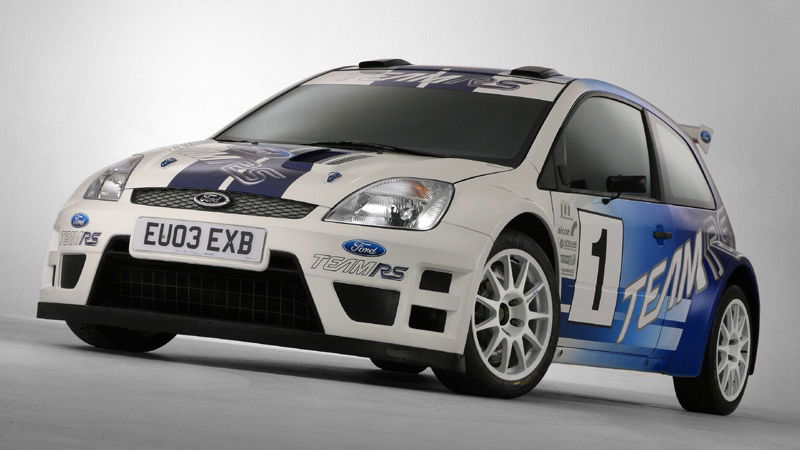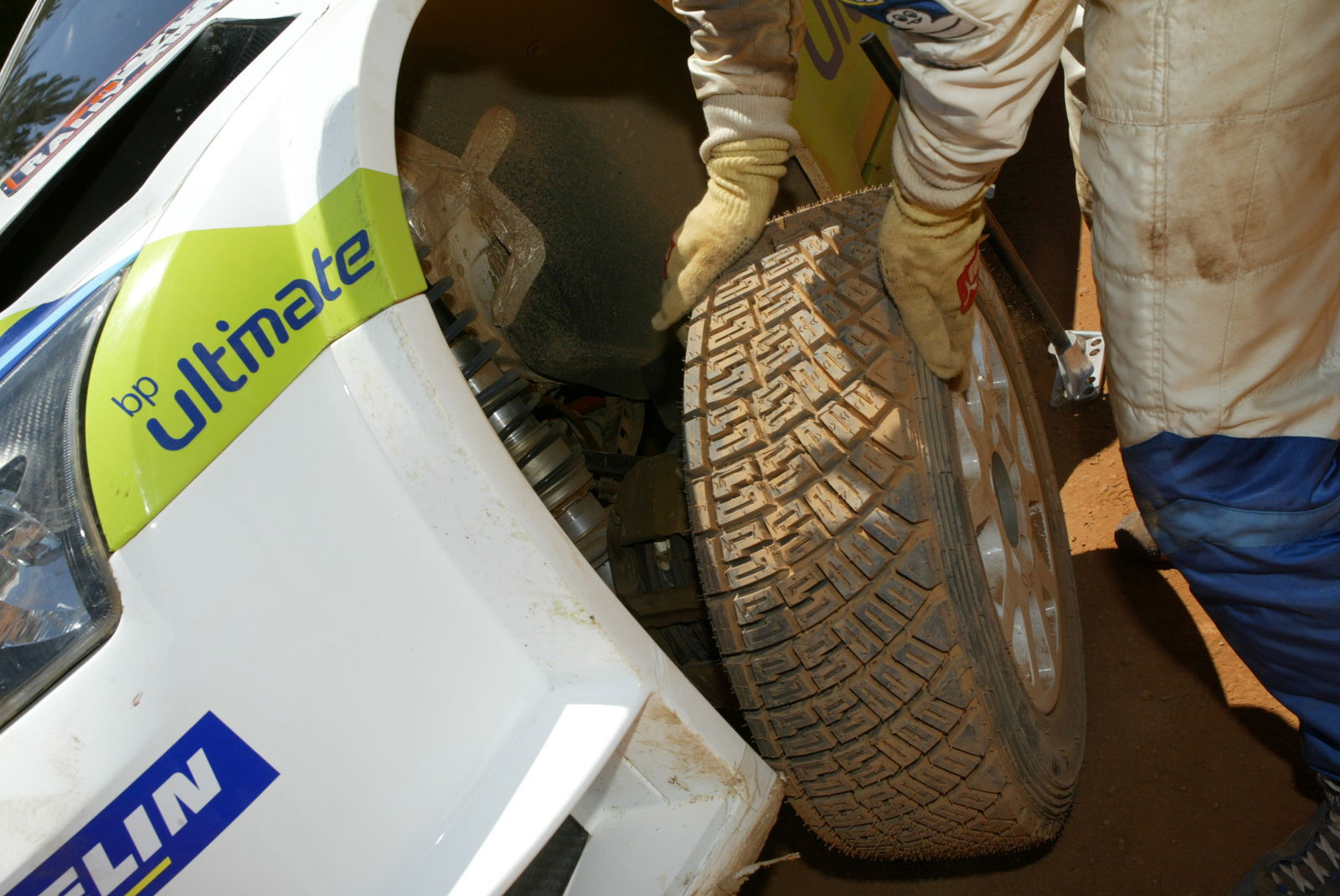Ford Focus RS WRC 06 - from concept to reality.
The Ford Focus RS WRC 06 that will contest the 2006 FIA World Rally Championship has been conceived, designed, built and developed in a staggeringly short space of time. Less than 12 months after Ford reconfirmed its long-term commitment to the WRC, the Focus RS WRC 06 made its debut and set fastest stage times on Rally Australia, the closing round of the 2005 championship.
How did BP-Ford World Rally Team technical director Christian Loriaux and his team of designers and engineers at M-Sport and Ford TeamRS manage this feat?

The Ford Focus RS WRC 06 that will contest the 2006 FIA World Rally Championship has been conceived, designed, built and developed in a staggeringly short space of time. Less than 12 months after Ford reconfirmed its long-term commitment to the WRC, the Focus RS WRC 06 made its debut and set fastest stage times on Rally Australia, the closing round of the 2005 championship.
How did BP-Ford World Rally Team technical director Christian Loriaux and his team of designers and engineers at M-Sport and Ford TeamRS manage this feat?
This timeline explains how they condensed a project that might have taken 18 months into less than 12 - and set technical benchmarks along the way...
November 2004
Ford of Europe confirms its commitment to the FIA WRC until 2008. In the vast workshops of M-Sport there are celebrations. And yet, at the same time, the team knows it will have barely a year to produce a brand new car, fit for new regulations that involve complex changes to the specification. The hard work is just beginning.
At M-Sport's Dovenby Hall base in north-west England, technical director Christian Loriaux and his 14-man team set up base in a closed-off area of the factory. There they will have access to computer-aided design facilities that will allow the team to share information and to analyse data with Ford engineers across Europe. They also support the testing of parts and theories on an extreme hydraulic rig.
All development work on the 2004-specification Focus RS WRC has ceased. Instead, Loriaux and his team will work solely towards the debut of the new-shape Focus RS WRC in time for the 2006 season.
January 2005
Loriaux has had access to design drawings of the new Ford Focus road car for a few weeks and the team begins to start work in earnest. They soon realise that as with the road-going Focus, the transition from current rally model to new will involve precious little carryover.
"You'd think with only nine months for the project that we'd be taking over a lot of the current car," he says. "But we've got elements like a brand new engine and a brand new transmission, and those are big bits on a rally car. There are a lot of key areas where we will see a big jump from the current car in terms of ideas and solutions."
After consultation with Ford TeamRS, the new car will be based on the forthcoming three-door Focus ST model, although World Rally Car rules will allow the team to use an all-alloy Duratec 2.0-litre engine from elsewhere in the Focus range, instead of the ST's 2.5-litre five-cylinder unit. The evolution of road car design, most notably the increased size of the new-shape Focus, presents Loriaux and his engineers with an interesting challenge - using a larger car but keeping the overall weight to a minimum.
In addition, new rules to be introduced in 2006 mean the car will not be permitted to use computer-controlled 'active' front and rear differentials. M-Sport's transmission partner, Ricardo, starts work on concepts for the solution, in close collaboration with M-Sport's own transmission engineer.
February 2005
M-Sport's designers are in constant contact with Ford TeamRS and Ford engineers in Cologne, Germany, and Dunton, England.
Ford's road car engineers have the powerful ADAMS software model at their disposal, and it is proving a useful tool as Loriaux and his team strive to come up with the best concept for the new car's layout.
"I know what I want in terms of suspension kinematics for the car," says Loriaux. "With the ADAMS model we liaise with Ford in Germany and they can supply us with useful information. We tell them where we're allowed to fit suspension points under the rules, for example, and give them my 'menu' of what I want to achieve and they come back with a solution. Of course, there are always compromises to be made and with the ADAMS model they're able to make me aware of them and of other potential solutions."
Loriaux's team begins an intensive period of exchanging data on the position of the engine, gearbox, differentials, suspension, fuel tank and driver and co-driver with Ford personnel in Cologne.
March 2005
M-Sport starts to develop a radical theory - and one that makes its already-tough deadline look even harsher. Instead of the Focus RS WRC making its debut in Monte Carlo 2006, the team decides to aim for a 'test' debut on the closing round of the 2005 season in Australia. The decision is made more complex because the long-haul nature of the event forces an extra week of travel time to be factored into the schedule.
Loriaux and his team now need to have the car running - testing, in anger and preferably on loose surfaces - by mid-October. The ADAMS software model work continues - and M-Sport also has a three-door Focus bodyshell on a jig to assess the stiffness and performance of various roll cage options.
April 2005
Work with Ford TeamRS and the Cologne road car department leads to the basic concept being finalised by late spring. It emerges that the car will use a transverse gearbox, a more conventional system compared with the radical solution fitted to all Focus WRCs since 1999.
"We think the advantages in weight distribution and loss of friction make it worthwhile to go transverse," says Loriaux.
May 2005
A new 10-tonne hydraulic actuator arrives and is swiftly put to good use, hammering suspension and chassis parts to test the theories in a monitored, controlled situation. This way, M-Sport engineers are able to corroborate the data provided by Ford TeamRS engineers, proving the theories and finalising the basic layout. A three-door bodyshell is now under preparation and the roll cage design is all-but-finalised. Layout is one thing - the detail work starts here.
June 2005
The toughest month for M-Sport's design team. If the Focus RS WRC is to run in September and be ready for its target of Rally Australia in mid-November, they need to finalise the detail design work on many of its parts this month. As such, late nights in the office become commonplace, with no-one leaving before midnight.
"It's been hell," admits Loriaux. "I feel for the guys because they know the end of the project is in sight but they have to get through the toughest part of it now if it's all going to happen."
Loriaux is keeping a close eye on suppliers to ensure parts will arrive on schedule, ready to be fitted once the first fully-prepared roll cage is available. The cage has already passed one important test, though - inspectors from motorsport's governing body, the FIA, have approved its design and safety in a two-part examination. And the first version of the new engine has arrived back from M-Sport's development partner, Pipo Moteur in France.
Using a multi-million pound transient dynamometer, the team's own engine specialists start to analyse performance and suggest modifications. In the end, a new crankshaft design is suggested, potentially delaying the engine by a month.
While development of the Focus RS WRC 04 has ceased, competition in the 2005 world championship has not. Loriaux uses this to his advantage by trying some of the 2006-specification suspension parts on a current car during testing for the notoriously rough Acropolis Rally in Greece.
July 2005
Designers continue to rack up long hours - their work continues to keep them in the office until midnight. The first components start to arrive. The Rally Australia deadline is still looming large and although M-Sport has caught up ground on its delay, non-design staff are also hard at work until 11pm every working day.
August 2005
Loriaux spots a potential delay. M-Sport and Ford TeamRS engineers have spent much of the summer finalising the new car's rear suspension design, but while they are delighted with the results of their collaboration, the time taken to reach a decision means that delivery of the rear uprights is going to be perilously close to the deadline for testing pre-Rally Australia.
Accordingly, M-Sport starts a separate build process on a back-up design, using its in-house machining capabilities to carve parts directly from a 60kg block of aluminium.
"We can't take the risk that this part will delay the project," says Loriaux. "A car with two front wheels and nothing at the rear won't be much use as we try to get ready for Australia!"
September 2005
The first bodyshell arrives, so M-Sport's mechanics can finally start to fit the relatively small stockpile of parts that are already prepared. A mock-up of the Focus' 2.0-litre engine arrives early in the month - it allows engineers to check its dimensions and all connections. However, M-Sport had set itself a target of having the car running before the end of September, and while a working motor arrives on schedule, its timing is tight. Determined to reach their goal, engineers complete the final elements of the basic installation late in the evening of September 30. In the dead of night, the car fires up for the first time. The Focus RS WRC is still restricted to M-Sport's workshops, but it is now a running car.
October 2005
In the first week of October, and again under cover of darkness, M-Sport engineers give the Focus RS WRC 06 its first taste of the outdoors by driving slowly around the company car park. The following week, the car is taken to Kirkbride Airfield in Cumbria for its initial shakedown. Engineers, including Loriaux himself, and M-Sport managing director Malcolm Wilson are there to help with the initial mileage. It proves encouraging enough for M-Sport to change its early testing plans - a proposed first asphalt test is replaced by an immediate switch onto gravel.
On October 18, with double British rally champion Mark Higgins behind the wheel, the Focus RS WRC 06 starts its first serious test in Whinlatter Forest, Cumbria. It goes on to compete almost 500km during its first three days, and more than 200km the following week.
Higgins is encouraged by the initial mileage. "The main aim is to rack up mileage before Rally Australia to identify any major shortcomings," he says, "and it's good that we've been able to do so much of that straight out of the box. Sometimes with a new car you lose days at a time but while we've had to keep an eye on progress and bear in mind that this car is scheduled to go to Rally Australia, we've still been able to push hard enough to find out a lot about how the car's going to behave on the stages."
Loriaux is thrilled at the car's early performance, but knows that sterner tests lie ahead. "I can hardly believe we've managed to get the car running so quickly, from a blank design board to here in only 10 months," he says. "But at the same time, I look at the car and I can't imagine it's going to Australia in a couple of weeks. We desperately want to get the mileage in competition because you can't substitute for that experience, but it's going to be tough."
November 2005
With fewer than 1,000 kilometres of gravel running to analyse on engineers' laptops, two examples of the Focus RS WRC 06 are shipped to Australia for the final round of the 2005 FIA World Rally Championship. Ford and M-Sport view the event as an extended test session for the car, since neither driver - Toni Gardemeister or Roman Kresta - has conducted any of the initial mileage.
Despite this, the car performs with relatively few problems and both drivers manage to set a fastest time - even though the 2006-specification transmission on the car is, in theory, less technically advanced than those fitted to the Focus' 2005-specification rivals. It is a tremendous achievement for M-Sport, Ford TeamRS and all the project partners.
Team principal Malcolm Wilson is delighted. "It's been a fantastic weekend," he says. "We came here to test and the most important target was to last the full distance with the car so we could learn as much as possible. Toni's car stopped on the penultimate special stage but the fact that we scored two fastest times is remarkable for a car which has been designed and built in such a short space of time. It has been a great effort from the whole team and we've shown the potential of the car for the future."
December 2005
The Focus RS WRC 06 will now undertake asphalt and snow tests in preparation for the start of its first full FIA World Rally Championship campaign, on the Monte Carlo Rally which takes place from 20 - 22 January, 2006.

